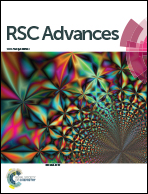Microwave-assisted synthesis of nitrogen-doped activated carbon as an oxygen reduction catalyst in microbial fuel cells†
Abstract
A nitrogen-doped activated carbon (NDAC) as a cathode catalyst in microbial fuel cells (MFCs) was synthesized by a microwave-assisted method using ammonium carbonate as a nitrogen source. The prepared NDAC showed a higher BET surface area of up to 1717.8 m2 g−1 and a total pore volume of 0.79 cm3 g−1. X-ray photoelectron spectroscopic analysis demonstrated that N was successfully doped on the surface of AC in three species, corresponding to pyrrolic N, pyridinic N and pyridine-N-oxide. Compared with untreated AC, the NDAC exhibited better electrocatalytic activity for the oxygen reduction reaction in rotating disk electrode tests, with a current density of 12.4 mA cm−2 at a set potential of −0.8 V (vs. SCE) (AC, 11.3 mA cm−2) and an electron transfer number of 3.14 (AC, n = 2.83). MFCs equipped with a NDAC cathode achieved a higher maximum power density of 471 ± 11 mW m−2 when fed with domestic wastewater, which was 1.3 times higher than that of the AC cathode. It also displayed long-term operation stability when dealing with real wastewater, indicating a promising cathode catalyst for MFCs towards practical applications.


 Please wait while we load your content...
Please wait while we load your content...